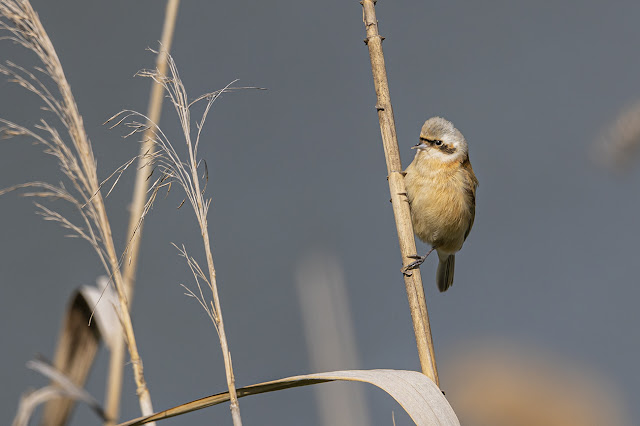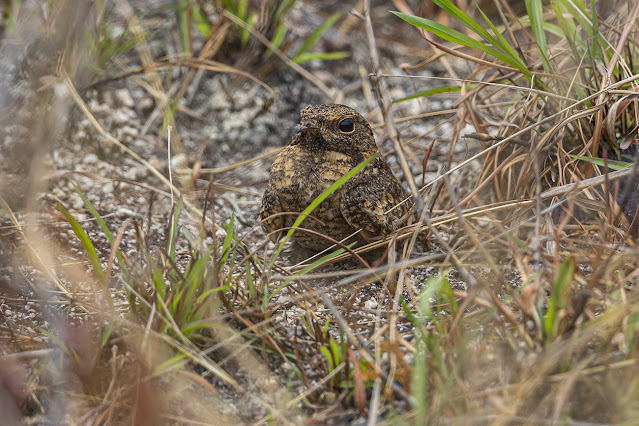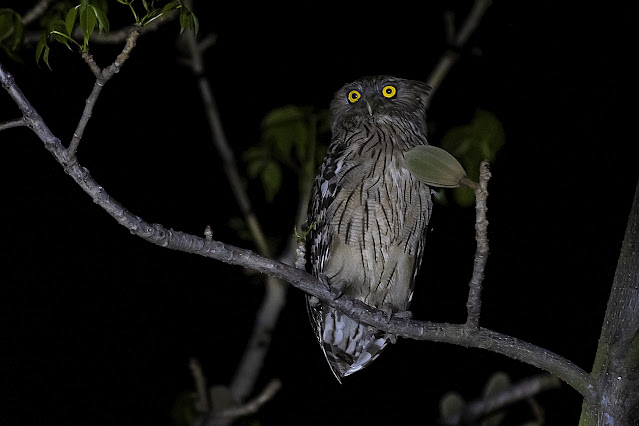A Spot-breasted Parrotbill was found by birders a few weeks back, and relocated recently. This species has never been recorded in Hong Kong before, but being a largely sedentary species, its appearance in Hong Kong is somewhat surprising. Being stuck in Hong Kong for two years now, I can't really say no to a crazy looking parrotbill! It took very little effort to relocate this very vocal bird, in a matter of minutes we were looking at this large and simply insane looking parrotbill. I've seen this species on my travels to northern Thailand, and viewing conditions were very similar, it perched up calling within a a few meters to us.
 |
| Spot-breasted Parrotbill |
Now the big question, is this bird an escapee or a genuine wild bird? The answer may not be as simple as we think. Historically we've had Grey-headed Parrotbills records from Hong Kong Island, they were considered as escapes, the live bird trade in Hong Kong is unfortunately alive and well, and we do find the odd exotic bird every so often, this could well have been brought to Hong Kong via pet trade, escaped or released somewhere and ended up on suitable habitats on Tai Mo Shan.
But, Hong Kong is well within the natural range of this species, with closest record just 200km east of Hong Kong. They are also found in northern Guangdong at sites such as Nanling and Chebaling. So, Hong Kong is well within reach for this species. As we have learnt in the past that sedentary species are capable of spreading from one patch of suitable habitat to another, who is to say that this could not have been a naturally spreading bird from nearby population that just ended up here? That being said, most species that naturally spread to Hong Kong will often see a spread in Guangdong first, I am not sure whether this species is showing sign of spread in Guangdong, though I've never seen this species at any of the forested sites near Hong Kong, although that could be due to the fact that we were looking at the wrong habitat, where this species require tall grass and shrubs to thrive, and we've mostly been looking at forested sites. My guess is that this will be first put into category III for now, until we see more clear signs of spread it will probably remain there. Either way, this is a fun bird to see and photograph and brings back joyful memories from northern Thailand!

 |
| Spot-breasted Parrotbill |
Tai Mo Shan is of course home to our local Vinous-throated Parrotbills, it was believed that the population here derived from caged birds as well, yet we are very well within its natural range, as this species is actually quite common throughout most of Guangdong.
 |
| Vinous-throated Parrotbill |
No visit to Tai Mo Shan is completed without at least trying for the Chinese Grassbird. Managed to find a fairly friendly one, singing out in the open. With such limited global distribution, I always feel very fortunate that we can find this species relatively easily in Hong Kong, and no doubt one of the top resident species here!
 |
| Chinese Grassbird |
Chinese Babax was heard only, this rare resident remains rather elusive. A Eurasian Hoopoe was a bit of a surprising find, I've never seen them up here before, although they are known to wander and can turn up almost anywhere. This one was seen feeding on the grass amongst the large boulders. I even got a new butterfly species while looking for birds up there, an Orange Punch, one of the three species of Riodinidae found in Hong Kong, and no doubt the best looking of the lot!
 |
| Eurasian Hoopoe |
 |
| Orange Punch |
As mid April approaches, more migratory waders are now arriving. The first of the Spoon-billed Sandpiper arrived, unfortunately I was a day late and missed the bird. Still, there were plenty of migrants to look at and often at close range. Terek Sandpipers now in very good numbers, and we are also seeing more Broad-billed Sandpipers. Red-necked Stints are common and will often walk right up to the bird hide. No less than 20 Nordmann's Greenshanks were feeding and resting on the mudflat, they have a habit of staying until the water is so high that they can barely stand on the mudflat.
 |
| Terek Sandpiper |
 |
| Broad-billed Sandpiper |
 |
| Red-necked Stint |
 |
| Nordmann's Greenshank |
There were plenty of Whimbrels feeding close to the bird hide, a few Far Eastern Curlews came relatively close, their brown rump is a feature best seen in flight. Their difference with the similar Eurasian Curlew don't stop there, Far Eastern Curlews also have marked underwing, as oppose to the plain underwing of Eurasian Curlews.
 |
| Whimbrel |
 |
| Far Eastern Curlew |
 |
| Eurasian Curlew |
Most Grey Herons are winter visitors in Hong Kong, although some do stay over summer. Great Egrets now moulted into their breeding plumage, with bright green facial skin and black bill. Little Egret is perhaps the most common egret species in Hong Kong, but it is often amongst them we find the much rarer Chinese Egret, a species that formerly bred in Hong Kong but now only as a migrant, spring is definitely the best time to see them as they moulted into the exquisite breeding plumage with beautiful head plumes. Almost equally exquisite looking are the many Black-faced Spoonbills in breeding plumage.
 |
| Great Egret & Grey Heron |
 |
| Little Egret |
 |
| Chinese Egret |
 |
| Black-faced Spoonbill |
Wintering Chinese Penduline Tits are still around, it is not difficult to find them feeding in reedbeds. Once you know their call, they are actually quite easy to locate, and you hear them everywhere!
 |
| Chinese Penduline Tit |
The drained pond at San Tin continues to provide some refuge to migrant waders, including a small flock of Sharp-tailed Sandpipers. They were feeding in the remaining puddles with numerous Long-toed Stints, the two species actually resembles one another in plumage, but very different in size. The exposed mud is the perfect nesting ground for Little Ringed Plover, their eggs perfectly camouflaged on the pebbled and shell littered ground.
 |
| Sharp-tailed Sandpiper & Long-toed Stint |
 |
| Little Ringed Plover |
Closer to home, breeding Hainan Blue Flycatchers are back, their songs can now be heard throughout the forest. The good weather and continued north easterly winds are not doing much in bringing in new migrants, the only notable migrant I got near home is a huge flock of Ashy Minivets, I estimated around 100 together, likely one of the largest congregation of Ashy Minivets in Hong Kong ever! As previous high count was 55 birds.
 |
| Hainan Blue Flycatcher - male |
 |
| Ashy Minivet - male |
 |
| Ashy Minivet - female |
I tried visiting the Ting Kok East Coast for migratory waders, but the tide was too high for any waders to be feeding there. The nearby grassy area hosted a single Little Bunting that was too quick for me to grab a photo, Yellow-bellied Prinias are in song and very confiding. One of the best bird present was a Siberian Rubythroat in song, though a bit far it was nice to see this usually skulking bird out in the open.
 |
| Yellow-bellied Prinia |
 |
| Siberian Rubythroat - male |













































































